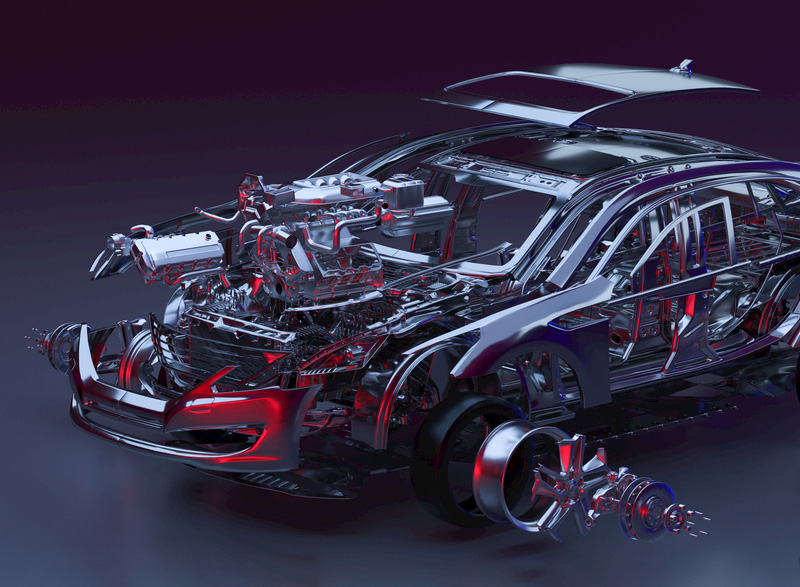10
2022.03
Nowadays, with the rapid development and application of automotive electronic technology, embedded technology, and virtual instrument technology, automotive electronic control has achieved great progress in terms of control accuracy, range, adaptability and intelligence. The progress has realized the overall optimized operation of the car. As the information source of the electronic control system of the motor vehicle, the automotive sensor is the key component of the electronic control system and one of the core contents of the electronic technology field of the motor vehicle.
Moreover, the sensors used in the vehicle will gradually improve, and the functions of the vehicle will be more perfect. There are many types of pressure sensors used in automobiles, some of which are mounted on the engine. For example, if we see a teapot-like oil warning light on the dashboard, it means that the oil pressure is low, which is an example of an oil pressure sensor application.

In addition, there are intake pressure sensors, high pressure fuel rail pressure sensors, etc., as well as air condition pressure sensors for the entire vehicle system. Now, let's analyze the role of these pressure sensors. The air conditioner pressure sensor is one of the most important sensors in the automotive refrigeration system. It is mainly used to monitor the refrigerant pressure in the air conditioner pipeline, prevent abnormal pressure from damaging the compressor, and cooperate with other components to control the opening and closing of the cooling fan and compressor.
The air conditioner pressure sensor is generally installed on the high pressure pipeline of the air conditioner in the engine compartment. The pressure signal collected is mainly output to the engine ECU or the control unit of the air conditioner. After the ECU receives the normal signal, it will send an instruction to control the compression. Turn on the machine and cooling fan. If it receives a pressure abnormal signal, it will refuse to open, so as not to damage the refrigeration system.
The damage of the air conditioner pressure sensor will lead to failures such as failure of refrigeration in the car, the inability of the compressor to run, or repeated start and stop. The corresponding fault code will be stored in the engine ECU or the air conditioner control module. When too much agent is added, the pressure in the air condition pipeline will be too high, the high pressure of the system will cause the condenser and high pressure pipeline to burst, and the exhaust valve and electromagnetic clutch of the compressor will be damaged.
When the system pressure reaches the upper limit, the high pressure switch will cut off the working circuit of the electromagnetic clutch, stop the compressor, and at the same time make the cooling fan of the condenser run at a high speed to reduce the pressure and temperature of the condenser, and the high pressure switch is usually installed in the liquid storage drying tank , or at the inlet of the condenser. Automotive pressure sensors are commonly used to measure the pressure of liquids and gases in vehicles, so they can be used in many in-vehicle systems.
On the basis of application segmentation, the automotive pressure sensor market can be segmented into transmission systems, engine control systems, power steering systems, HVAC systems, airbags, anti-lock braking systems, and direct tire pressure monitoring systems, and is expected to Will occupy the largest share of the automotive pressure sensor market.
In fact, a pressure sensor is a device or device that can sense the pressure signal and convert the pressure signal into an available output electrical signal according to certain rules. It usually consists of pressure sensitive components and signal processing units. According to the different types of test pressure, pressure sensors can be divided into gauge pressure sensors, differential pressure sensors and absolute pressure sensors.
It is the most commonly used sensor in industrial practice and is widely used in various industrial automatic control environments, involving water conservancy and hydropower, railway transportation, intelligent buildings, production automatic control, aerospace, military, petrochemical, oil wells, electric power, ships, machine tools, Pipelines and other industries. The structure of the oil pressure sensor is mainly composed of a sealing ring, a ceramic capacitor, an O-ring, a hexagonal copper tube and an outer sealing ring.
When there is no oil pressure, the spring pushes the diaphragm and the contact is closed; when the oil pressure reaches the specified value, the diaphragm overcomes the spring force to disconnect the contact; when the oil pressure is within a reasonable range, the diaphragm does not push The force of the spring, the contacts are closed, and the oil warning light does not come on. If the car is difficult to start, idling, shakes, or emits black smoke, check for a faulty or damaged air temperature sensor.
If the air temperature sensor is faulty or damaged, the engine will not be able to accurately calculate the amount of fuel injected, resulting in a mixture that is too rich or too lean, which affects the performance of the engine. If the car is in a cold state, it will be difficult to start, idling unstable, shaking, and weak in acceleration; when the engine is very hot, the engine fault indicator light will stay on and the fan will stop running.
At this time, it is necessary to check whether the temperature sensor of the coolant is faulty or damaged. If the temperature sensor of the coolant is faulty or damaged, then the engine will not be able to adjust the water temperature in time, and the engine will not get Cooling, it will be prone to the phenomenon of boiling and pulling the cylinder.
In summary, due to the development and application of new technologies such as electronic technology, computer technology, and information technology, automotive electronic control has made great progress in terms of control accuracy, range, adaptability, intelligence, etc. Overall optimized operation of the car. Therefore, electronic control technology has obvious advantages in reducing emission pollution, reducing fuel consumption, and improving safety and comfort.
